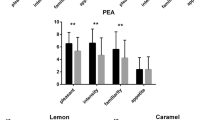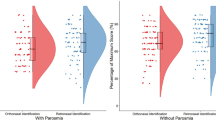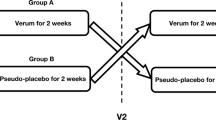Abstract
Introduction
Olfaction is a highly emotionally charged sense and contributes to our quality of life, which olfactory impairment or dysosmia thus strongly impacts. The aim of the present study was to examine how olfactory deficits alter eating behavior, which is a pillar of health and well-being.
Methods
Patients with quantitative smell impairment and control participants were asked to perform a series of chemosensory tasks: odor identification and ratings of odor intensity, pleasantness, familiarity, irritation, and edibility. They also filled out a detailed food questionnaire.
Results
Results showed significant decrease in olfactory function in smell-impaired patients. Although no significant consequences of dysosmia were found for most aspects of food preferences and culinary habits, the patients were less attracted than controls by novel foods and tended to experience less pleasure when eating. They also used significantly more condiments such as sugar, mayonnaise, or sour cream to make their dishes tasty.
Conclusions
Olfactory impairment has a clear effect on certain aspects of eating behavior.
Implications
These findings highlight the compensatory mechanisms that go along with dysosmia. This also reflects the patients’ attempts to restore part of the lost flavor and its hedonic component through non-olfactory cues.





Similar content being viewed by others
References
Arganini C, Sinesio F (2015) Chemosensory impairment does not diminish eating pleasure and appetite in independently living older adults. Maturitas 82:241–244
Aschenbrenner K, Hummel C, Teszmer K et al (2008) The influence of olfactory loss on dietary behaviors. Laryngoscope 118:135–144. https://doi.org/10.1097/MLG.0b013e318155a4b9
Blomqvist EH, Bramerson A, Stjarne P, Nordin S (2004) Consequences of olfactory loss and adopted coping strategies. Rhinology 42:189–194
Bramerson A, Johansson L, Ek L et al (2004) Prevalence of olfactory dysfunction: the Skövde population-based study. Laryngoscope 114:733–737
Croy I, Hummel T (2017) Olfaction as a marker for depression. J Neurol 264:631–638. https://doi.org/10.1007/s00415-016-8227-8
Croy I, Bojanowski V, Hummel T (2013) Men without a sense of smell exhibit a strongly reduced number of sexual relationships, women exhibit reduced partnership security—a reanalysis of previously published data. Biol Psychol 92:292–294. https://doi.org/10.1016/j.biopsycho.2012.11.008
Croy I, Nordin S, Hummel T (2014) Olfactory disorders and quality of life—an updated review. Chem Senses 39:185–194. https://doi.org/10.1093/chemse/bjt072
Ferris AM, Duffy VB (1988) Effect of olfactory deficits on nutritional status does age predict persons at risk? Ann N Y Acad Sci 561:113–123
Gudziol H, Schubert M, Hummel T (2001) Decreased trigeminal sensitivity in anosmia. ORL 63:72–75
Henkin RI (2014) Effects of smell loss (hyposmia) on salt usage. Nutrition 30:690–695
Hummel T, Kobal G, Gudziol H, Mackay-Sim A (2007) Normative data for the “Sniffin’ Sticks” including tests of odor identification, odor discrimination, and olfactory thresholds: an upgrade based on a group of more than 3,000 subjects. Eur Arch Oto-Rhino-Laryngol Off J Eur Fed Oto-Rhino-Laryngol Soc EUFOS Affil Ger Soc Oto-Rhino-Laryngol - Head Neck Surg 264:237–243. https://doi.org/10.1007/s00405-006-0173-0
Hummel T, Whitcroft KL, Andrews P et al (2017) Position paper on olfactory dysfunction. Rhinology. https://doi.org/10.4193/Rhin16.248
Jaeger SR, McRae JF, Bava CM et al (2013) A Mendelian trait for olfactory sensitivity affects odor experience and food selection. Curr Biol 23:1601–1605
Joussain P, Bessy M, Faure F et al (2016) Application of the European Test of Olfactory Capabilities in patients with olfactory impairment. Eur Arch Oto-Rhino-Laryngol Off J Eur Fed Oto-Rhino-Laryngol Soc EUFOS Affil Ger Soc Oto-Rhino-Laryngol - Head Neck Surg 273:381–390. https://doi.org/10.1007/s00405-015-3536-6
Keller A, Malaspina D (2013) Hidden consequences of olfactory dysfunction: a patient report series. BMC Ear Nose Throat Disord 13:8. https://doi.org/10.1186/1472-6815-13-8
Landis BN, Konnerth CG, Hummel T (2004) A study on the frequency of olfactory dysfunction. Laryngoscope 114:1764–1769
Landis BN, Scheibe M, Weber C et al (2010) Chemosensory interaction: acquired olfactory impairment is associated with decreased taste function. J Neurol 257:1303–1308
Mattes RD, Cowart B, Schiavo MA, Lowry LD (1990) Dietary evaluation of patients with smell and/or taste disorders. Am J Clin Nutr 51:233–240
McRae JF, Mainland JD, Jaeger SR et al (2012) Genetic variation in the odorant receptor OR2J3 is associated with the ability to detect the “grassy” smelling odor, cis-3-hexen-1-ol. Chem Senses 37:585–593
Merkonidis C, Grosse F, Ninh T et al (2015) Characteristics of chemosensory disorders—results from a survey. Eur Arch Otorhinolaryngol 272:1403–1416. https://doi.org/10.1007/s00405-014-3210-4
Murphy C (2002) Prevalence of olfactory impairment in older adults. JAMA 288:2307. https://doi.org/10.1001/jama.288.18.2307
Razafindrazaka H, Monnereau A, Razafindrazaka D et al (2015) Genetic admixture and flavor preferences: androstenone sensitivity in Malagasy populations. Hum Biol 87:59–70
Santos DV, Reiter ER, DiNardo LJ, Costanzo RM (2004) Hazardous events associated with impaired olfactory function. Arch Otolaryngol Neck Surg 130:317–319
Smeets MAM, Veldhuizen MG (2009) Sense of smell disorder and health-related quality of life. Rehabil Psychol 54:404–412
Author information
Authors and Affiliations
Corresponding author
Ethics declarations
Funding
This study was funded by a grant from the Interdisciplinary Mission of the CNRS (DEFISENS call, PREVALOF and O2C2 projects; DEGIGENRE call, Sensotogenre project) to MB and a grant from Region Rhone-Alpes ARC2 Qualité de vie et Vieillissement ADR to CM. The study was also supported by a grant from the Deutsche Forschungsgemeinschaft to TH (DFG HU411/18-1).
Conflict of Interest
The authors have declared no conflict of interest.
Ethical Approval
All procedures performed in studies involving human participants were in accordance with the ethical standards of the institutional and/or national research committee and with the 1964 Helsinki Declaration and its later amendments or comparable ethical standards.
Informed Consent
Informed consent was obtained from all individual participants included in the study.
Electronic Supplementary Material
ESM 1
(DOCX 196 kb)
Rights and permissions
About this article
Cite this article
Manesse, C., Ferdenzi, C., Sabri, M. et al. Dysosmia-Associated Changes in Eating Behavior. Chem. Percept. 10, 104–113 (2017). https://doi.org/10.1007/s12078-017-9237-3
Received:
Accepted:
Published:
Issue Date:
DOI: https://doi.org/10.1007/s12078-017-9237-3




